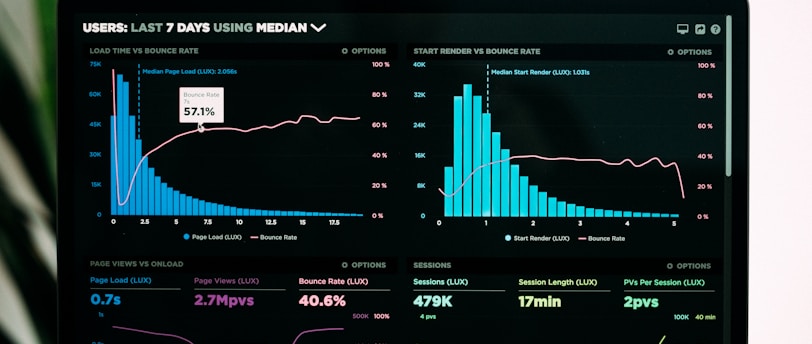Measure Your Impact: Analytics and Reporting for Corporate Video Success
Unlock key insights into viewer behavior and content effectiveness with video analytics. Learn about KPIs, reporting, and how to optimize your corporate video strategy for maximum impact.
Alden Media Group
5/11/20245 min read


Understanding Video Analytics
Video analytics is an essential component of any corporate video strategy, providing critical insights into viewer behavior and content effectiveness. By examining key metrics such as view counts, engagement rates, and audience demographics, organizations can gain a comprehensive understanding of how their video content resonates with viewers. These metrics not only reflect the immediate success of a video but also help in shaping future content strategies.
View counts are one of the most straightforward indicators of a video's reach. They provide a quantitative measure of how many times a video has been viewed, allowing businesses to gauge interest levels and initial audience attraction. However, raw view count numbers do not tell the complete story. To delve deeper, engagement rates offer a more nuanced perspective, showcasing the percentage of viewers who interact with the video through likes, comments, shares, or completing the video. A high engagement rate typically indicates that the content is resonating positively with its audience, thus enabling companies to adjust their messaging or creative direction accordingly.
Another critical metric is audience demographics, which includes information such as the age, gender, and location of viewers. Understanding these demographics can help companies tailor their messaging more effectively, ensuring that the right content reaches the right audience. Collecting data from video platforms is therefore vital; these platforms often offer built-in analytics tools that track viewer interactions in real time, presenting valuable insights that can inform future content development.
Moreover, various tools and software exist to facilitate video analytics, helping organizations streamline their data collection processes. Solutions like Google Analytics, Vidyard, and Wistia provide comprehensive reports, enabling businesses to access real-time data and visualize viewer trends. By leveraging these analytics tools, companies can make more informed decisions about their video marketing strategies and optimize them for better results.
Key Performance Indicators (KPIs) for Corporate Videos
Understanding and selecting appropriate Key Performance Indicators (KPIs) is crucial for evaluating the effectiveness of corporate videos. These metrics not only provide insights into the audience's engagement but also help in aligning video content with overarching business objectives. When setting out to measure the success of a corporate video, it is essential first to establish clear objectives. These objectives will guide the selection of KPIs, ensuring they reflect the goals of the video—whether it is brand awareness, lead generation, or educational outreach.
Some of the most relevant KPIs for corporate videos include video completion rates, which indicate the percentage of viewers who watch the video to the end. High completion rates signify that the content resonates with the audience, whereas low rates may suggest that the video requires edits to enhance engagement. Shares and comments are also vital KPIs, as they reflect viewer interaction and the likelihood of content going viral. For instance, a video that garners numerous shares may reach broader audiences, thereby amplifying brand recognition.
Click-through rates (CTR) are another essential metric, particularly for videos intended to drive traffic to a website or landing page. A high CTR indicates that the video successfully prompts viewers to take the desired action, further validating its effectiveness. When selecting KPIs, businesses should consider their target audience and the specific outcome they hope to achieve. By doing so, organizations can tailor their video strategy for maximum impact.
Incorporating practical examples and case studies allows businesses to see how these KPIs can be effectively applied in various scenarios. Understanding real-world applications of these metrics can enhance strategy formulation, ultimately contributing to a higher return on investment (ROI) for corporate video initiatives.
Reporting and Interpreting Video Analytics Data
Effectively reporting and interpreting video analytics data is fundamental for maximizing the impact of corporate video content. First and foremost, the collection of analytics should be systematically organized. By utilizing dedicated analytics tools, businesses can harness data from multiple platforms, ensuring comprehensive insights into viewer engagement, retention rates, and demographic details. Capturing this data is only the initial step; the subsequent challenge lies in how to present and interpret it for stakeholders.
Dashboards play a crucial role in transforming raw data into an easily digestible format. Visualizations such as graphs, charts, and heatmaps can enhance understanding, allowing stakeholders to quickly identify patterns or anomalies in viewer behavior. For example, a line graph depicting viewer retention over time can reveal trends that necessitate adjustments in content strategy. When presenting this data, it is essential to tailor reports to meet the expectations of the audience, emphasizing key performance indicators (KPIs) that matter most to them, such as conversion rates or engagement levels.
In addition to creating visually appealing reports, the interpretation of these insights is paramount. Extracting actionable insights from video analytics allows businesses to make informed decisions. For instance, analyzing the drop-off points in a video can indicate sections that may need improvement, while high engagement in particular segments can highlight successful content strategies worth replicating. By effectively interpreting video analytics data, companies can drive strategic initiatives and enhance their content development.
Moreover, fostering communication around video analytics reporting is essential for demonstrating the value of corporate video initiatives. Establishing a regular reporting cadence and sharing insights with relevant stakeholders reinforces accountability and collaboration. Ultimately, an organized approach to reporting and interpreting video analytics data not only showcases ROI but also empowers businesses to leverage video content more effectively in achieving their corporate objectives.
Optimizing Future Corporate Videos Based on Analytics Findings
In today’s competitive landscape, understanding the performance of corporate videos through analytics is vital for success. The insights gathered from viewer engagement can fundamentally shape the content creation process, leading to increased effectiveness of future video productions. A data-driven approach not only enhances the quality but also promotes strategic alignment with audience preferences.
To begin optimizing future corporate videos, it is crucial to analyze existing data to uncover trending themes, engagement metrics, and audience demographics. For instance, if a particular video format or topic yields higher engagement rates or viewer duration, it becomes essential to identify and replicate these successful elements in subsequent productions. Various analytics tools can dissect viewers' behaviors, revealing which segments hold the audience's attention and which fall short. This iterative process allows creators to refine their content, ensuring alignment with audience interests and expectations.
Moreover, it is equally important to recognize the aspects of past videos that may need improvement. Analyzing drop-off rates can point to sections of the video that lose viewer interest, necessitating adjustments in pacing, style, or even messaging. Feedback gathered through comments and surveys also plays a crucial role, providing qualitative insights that numbers alone might not reveal. By leveraging these insights, content creators can formulate a clear vision for improvements and experimentation.
Ultimately, the cycle of measuring, analyzing, and optimizing must be continuous. Each corporate video serves not just as a marketing tool but as a valuable lesson in viewer engagement. By adopting a structured approach to utilize analytics findings, organizations can enhance their corporate video strategies, driving greater impacts and fostering deeper connections with their audiences. Embracing this feedback loop is essential for sustained success in the evolving realm of video marketing.
From idea to impact, always in frame.
connect
info@aldenmediagroup.com
+639185621210
© 2025. All rights reserved.
